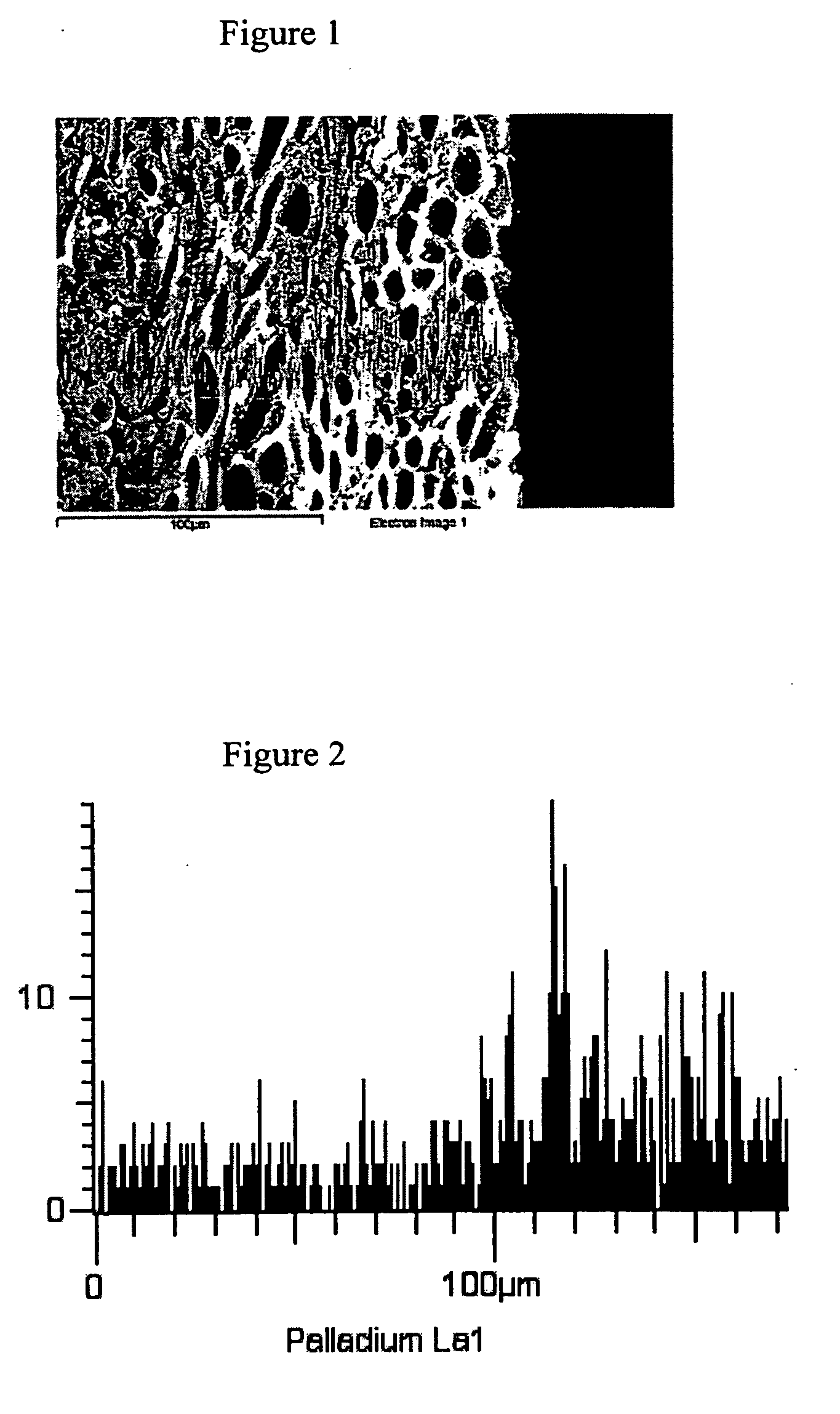Hydrogenation catalyst, its preparation and use
a hydrogenation catalyst and catalyst technology, applied in the field of catalytic, can solve the problems of increasing the surface area of palladium and the decrease of catalytic activity, the support cannot be sufficiently agitated under mechanical stirring, and the loss of metallic palladium caused by the erosion of stuffs, etc., to achieve excellent performance, increase activity and/or selectivity, and prolong service life
- Summary
- Abstract
- Description
- Claims
- Application Information
AI Technical Summary
Benefits of technology
Problems solved by technology
Method used
Image
Examples
example 1
Catalyst A
[0046] 500 g of the pretreated activated coconut carbon with a size of 4-8 mesh were weighed, rinsed with water to remove carbon fines, and then placed in a 5000 ml four-necked flask. 2000 ml water was added, stirred by a stirrer under aqueous solution and above carbon layer. 1000 ml of the palladium salt oxidization solution as above formulated was added and was adsorbed at room temperature under stirring until the impregnating solution was colorless. Under stirring, 500 ml of 5% Na2CO3 aqueous solution was added and maintained for 2 hours at room temperature, and then 500 ml of formaldehyde was added to perform the reduction reaction at room temperature or slightly above for 4 hours, following by filtering, washing with deionized water until no chlorine ion was datable. The catalyst was discharged from the flask, and dried at 110° C. for 5 hours.
example 2
Catalyst B
[0047] 500 g of pretreated activated coconut carbon with a size of 4-8 mesh were weighed, rinsed with water to remove carbon fines, and placed in the fluidized bed. 5000 ml water was added, and circulated at a flow rate of 1.2 L / min by using a pump, wherein the activated carbon was immobilized as a fixed bed for adsorption. Then, 1000 ml of the palladium salt oxidization solution as above formulated was added and the impregnation was performed at room temperature until the impregnating solution was colorless. Under stirring, 500 ml of 5% Na2CO3 aqueous solution was added and maintained for 2 hours at room temperature, and then 500 ml of formaldehyde was added to perform the reduction reaction at room temperature or slightly above for 4 hours, following by filtering, washing with deionized water until no chlorine ion was datable. The catalyst was discharged from the fluidized bed, and dried at 110° C. for 5 hours.
example 3
Catalyst C
[0048] 500 g of pretreated activated coconut carbon with a size of 4-8 mesh were weighed, rinsed with water to remove carbon fines, and placed in the fluidized bed. 5000 ml water was added, and circulated at a flow rate of 3.0 L / min by using a pump, wherein the activated carbon was slightly moved as a fixed-fluidized bed for adsorption. Then, 1000 ml of the palladium salt oxidization solution as above formulated was added and the impregnation was performed at room temperature until the impregnating solution was colorless. Under stirring, 500 ml of 5% Na2CO3 aqueous solution was added and maintained for 2 hours at room temperature, and then 500 ml of formaldehyde was added to perform the reduction reaction at room temperature or slightly above for 4 hours, following by filtering, washing with deionized water until no chlorine ion was datable. The catalyst was discharged from the fluidized bed, and dried at 110° C. for 5 hours.
PUM
| Property | Measurement | Unit |
|---|---|---|
| Temperature | aaaaa | aaaaa |
| Fraction | aaaaa | aaaaa |
| Fraction | aaaaa | aaaaa |
Abstract
Description
Claims
Application Information
 Login to View More
Login to View More - R&D
- Intellectual Property
- Life Sciences
- Materials
- Tech Scout
- Unparalleled Data Quality
- Higher Quality Content
- 60% Fewer Hallucinations
Browse by: Latest US Patents, China's latest patents, Technical Efficacy Thesaurus, Application Domain, Technology Topic, Popular Technical Reports.
© 2025 PatSnap. All rights reserved.Legal|Privacy policy|Modern Slavery Act Transparency Statement|Sitemap|About US| Contact US: help@patsnap.com


